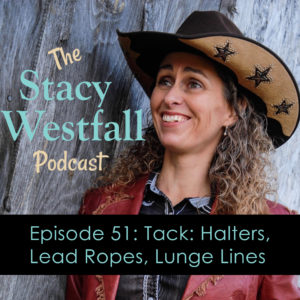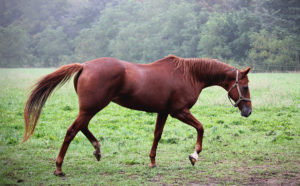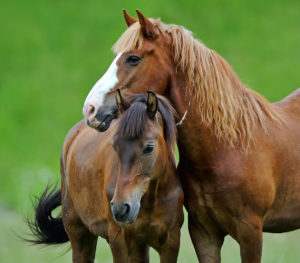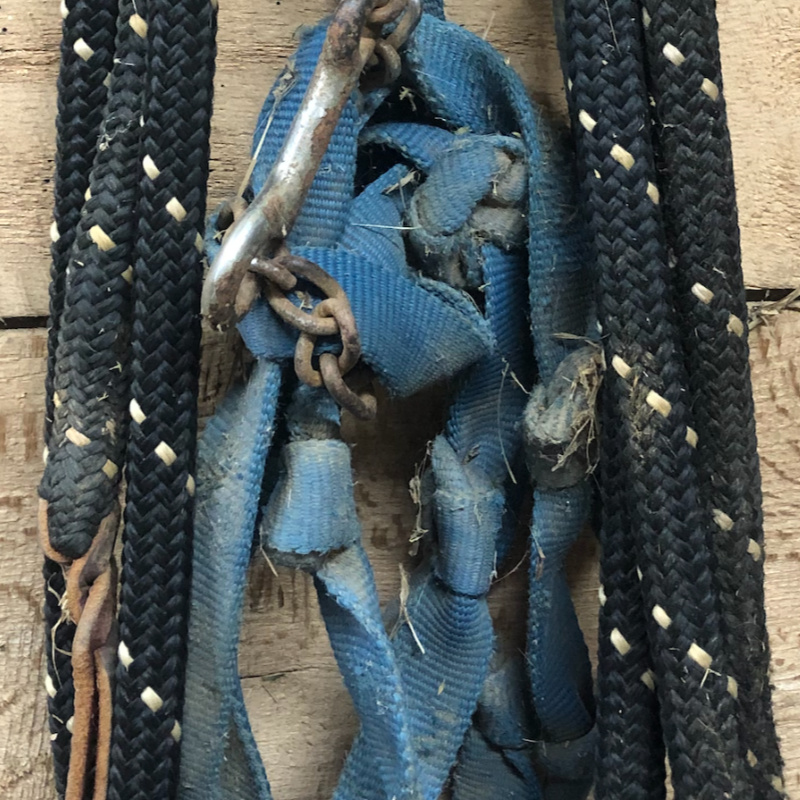Episode 51: Tack: Halters, Lead Ropes, Lunge Lines

In this season, I’m going to explain some of the choices in tack and equipment available. I’ll also share what I’m using and why. Today’s focus is some of the items used when leading the horse. Things like halters, lead ropes, and lunge lines. I’m also going to introduce you to a friend of mine who owns a tack store. I’m also going to close out the episode with a sad story. I’ll also give you the biggest training tip that matches this discussion. Equipment is such a huge topic that it’s even a challenge to break it down.
If I don’t talk about something you’ve been wondering about, please leave me a voice message or send me an email. This a no judgement zone. I know you can feel a little lost sometimes when it comes to tack. There are also new items and new things to learn all the time. That’s why it’s so great to have a friend who owns a tack store. I hope you enjoy my conversation with Trish Campese owner of The Stagecoach West. Stagecoach West is a family store started by Trish’s Dad. Next year, the store will be 40 years old.
“A rope halter adds a little more pressure, but doesn't have any of the other issues that chains would have.” Stacy Westfall Click To TweetShow Notes:
[02:45] There are many different halter options. At Stagecoach West, they would ask you different questions about your horse. Pictures are helpful too. Then they would try to help you with sizing. They would also get information like if the horse is stalled or turned out or both. Then on to the materials.
[03:41] Current halter trends include bright colors and breakaway nylon.
[04:52] They have almost every color imaginable of lead ropes. Polypropylene is the number one material. There are stamps, chains, and even bamboo.
[08:59] Pictures are helpful when determining the right halter.
[10:04] In my barn, the first thing I’m going to touch is some version of a halter and lead rope. I have a quick catch halter, rope halters, nylon halters, and leather halters.

[10:36] I use the leather halter the least.
[11:45] I use the nylon halters more often. Both are a wider flat fit. Nylon can be soft and comes in different colors.
[14:40] I use the rope and quick catch the most. The only adjustment on the rope halter is the crown piece.
[15:46] Flat halters distribute pressure over a wider area.
[16:31] The rope halter has a more narrow pressure point. It’s a go to for function and feel.
[17:51] I use the quick catch halter a lot too. It’s good for leading horses from one place to another.

[20:45] I would use the flat nylon or flat leather for hauling horses.
[22:28] I like the poly lead rope, because it doesn’t pick up sawdust or dirt when I drop it.
[23:22] When it’s time to work the horse I use one of the training ropes. The big difference is that these ropes have a core and don’t tangle easily.
[27:34] You need a quality stick and string that has enough weight to make noise and be easily controlled. Get the one with the nice heavy core.
[30:43] You have to practice with your tools to get good at using them and working with your horse.
[31:29] Use the tools that a lot of trainers use. Once you know how to use them, they have a better feel and will benefit you.
[33:50] In training, it’s about clarity. When your horse has a lot of training the halter doesn’t make much of a difference.

[35:47] Stacy shares a story where they used loose tie rings at a facility that actually taught the horses to pull.
[37:45] I’m not a fan of flat web lunge lines.
[38:06] Stacy shares a story about a woman who was lunging a horse with a flat web lunge line, and the horse bolted and her fingers were tangled, and she was dragged by the horse and smashed into the rails of the arena. She lost her four fingers and was permanently in a wheelchair.
[40:39] If you have a piece of equipment that’s tying itself in knots, it’s a warning that this material is more likely to cause injury.
[41:04] It’s important to know how to use your equipment, but it’s also important to train your horse to understand how to respond under pressure.
“It's important to know how to use your equipment, but it's also important to train your horse to understand how to respond under pressure.” Stacy Westfall Click To TweetLinks and Resources:
WestfallHorsemanship@gmail.com
The Stagecoach West Use the code Stacy for 15% off your entire order excluding saddles.
The Stagecoach West on Facebook
To learn more or to purchase these items please follow these links:
Quick catch halter on Amazon: https://amzn.to/34E34rv
Quick catch halter at Stagecoach West (code ‘Stacy’ for 15% off entire order) https://www.stagecoachwest.com/western/westfall-horsemanship/ropes-halters/stacy-westfall-catch-halter-average.html
Rope halter on Amazon-Weaver Leather Stacy Westfall Rope Halter, Medium, Black with Blue Nose: https://amzn.to/2vIdgQl
Rope halter at Stagecoach West (code ‘Stacy’ for 15% off entire order) https://www.stagecoachwest.com/western/westfall-horsemanship/ropes-halters.html?___SID=U
Amazon-Weaver Leather Stacy Westfall Stick and String: https://amzn.to/2VcOZ3G
Amazon-Weaver Leather Stacy Westfall Training Rope-https://amzn.to/32iV90X
Flat lunge line material vs high quality lunge line rope with a core.
Beware of any material that naturally ties itself in knots. I found this blue lunge line
in a barn where I was asked to help with a horse. I traded them a rope with a core (like this black and tan rope) so I
could keep this blue rope as a warning message to others: these ropes are unsafe!

Flat lunge lines often tie themselves in knots. High quality ropes with a core are much less likely to do so.
SUBSCRIBE TO THE PODCAST HERE:





YOURS FREE
WHY IS MY HORSE...?

